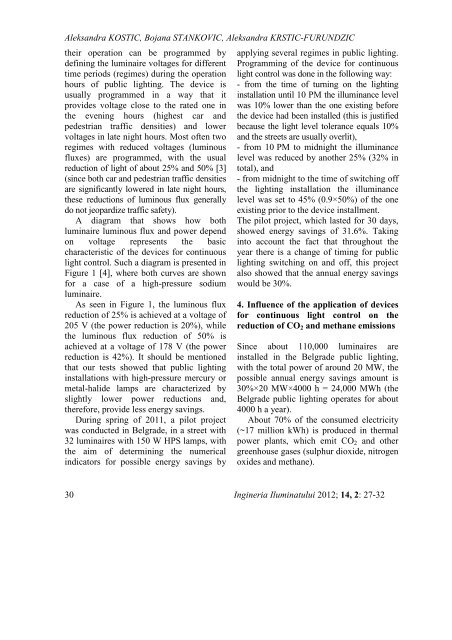Untitled - Journal of Lighting Engineering
Untitled - Journal of Lighting Engineering
Untitled - Journal of Lighting Engineering
You also want an ePaper? Increase the reach of your titles
YUMPU automatically turns print PDFs into web optimized ePapers that Google loves.
Aleksandra KOSTIC, Bojana STANKOVIC, Aleksandra KRSTIC-FURUNDZIC<br />
their operation can be programmed by<br />
defining the luminaire voltages for different<br />
time periods (regimes) during the operation<br />
hours <strong>of</strong> public lighting. The device is<br />
usually programmed in a way that it<br />
provides voltage close to the rated one in<br />
the evening hours (highest car and<br />
pedestrian traffic densities) and lower<br />
voltages in late night hours. Most <strong>of</strong>ten two<br />
regimes with reduced voltages (luminous<br />
fluxes) are programmed, with the usual<br />
reduction <strong>of</strong> light <strong>of</strong> about 25% and 50% [3]<br />
(since both car and pedestrian traffic densities<br />
are significantly lowered in late night hours,<br />
these reductions <strong>of</strong> luminous flux generally<br />
do not jeopardize traffic safety).<br />
A diagram that shows how both<br />
luminaire luminous flux and power depend<br />
on voltage represents the basic<br />
characteristic <strong>of</strong> the devices for continuous<br />
light control. Such a diagram is presented in<br />
Figure 1 [4], where both curves are shown<br />
for a case <strong>of</strong> a high-pressure sodium<br />
luminaire.<br />
As seen in Figure 1, the luminous flux<br />
reduction <strong>of</strong> 25% is achieved at a voltage <strong>of</strong><br />
205 V (the power reduction is 20%), while<br />
the luminous flux reduction <strong>of</strong> 50% is<br />
achieved at a voltage <strong>of</strong> 178 V (the power<br />
reduction is 42%). It should be mentioned<br />
that our tests showed that public lighting<br />
installations with high-pressure mercury or<br />
metal-halide lamps are characterized by<br />
slightly lower power reductions and,<br />
therefore, provide less energy savings.<br />
During spring <strong>of</strong> 2011, a pilot project<br />
was conducted in Belgrade, in a street with<br />
32 luminaires with 150 W HPS lamps, with<br />
the aim <strong>of</strong> determining the numerical<br />
indicators for possible energy savings by<br />
30<br />
applying several regimes in public lighting.<br />
Programming <strong>of</strong> the device for continuous<br />
light control was done in the following way:<br />
- from the time <strong>of</strong> turning on the lighting<br />
installation until 10iPM the illuminance level<br />
was 10% lower than the one existing before<br />
the device had been installed (this is justified<br />
because the light level tolerance equals 10%<br />
and the streets are usually overlit),<br />
- from 10iPM to midnight the illuminance<br />
level was reduced by another 25% (32% in<br />
total), and<br />
- from midnight to the time <strong>of</strong> switching <strong>of</strong>f<br />
the lighting installation the illuminance<br />
level was set to 45% (0.9×50%) <strong>of</strong> the one<br />
existing prior to the device installment.<br />
The pilot project, which lasted for 30 days,<br />
showed energy savings <strong>of</strong> 31.6%. Taking<br />
into account the fact that throughout the<br />
year there is a change <strong>of</strong> timing for public<br />
lighting switching on and <strong>of</strong>f, this project<br />
also showed that the annual energy savings<br />
would be 30%.<br />
4. Influence <strong>of</strong> the application <strong>of</strong> devices<br />
for continuous light control on the<br />
reduction <strong>of</strong> CO2 and methane emissions<br />
Since about 110,000 luminaires are<br />
installed in the Belgrade public lighting,<br />
with the total power <strong>of</strong> around 20 MW, the<br />
possible annual energy savings amount is<br />
30%×20 MW×4000 h = 24,000 MWh (the<br />
Belgrade public lighting operates for about<br />
4000 h a year).<br />
About 70% <strong>of</strong> the consumed electricity<br />
(~17 million kWh) is produced in thermal<br />
power plants, which emit CO2 and other<br />
greenhouse gases (sulphur dioxide, nitrogen<br />
oxides and methane).<br />
Ingineria Iluminatului 2012; 14, 2: 27-32
















